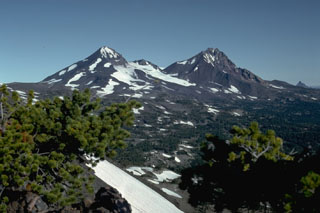Report on Three Sisters (United States) — 26 January-1 February 2022
Smithsonian Institution / US Geological Survey
Weekly Volcanic Activity Report, 26 January-1 February 2022
Managing Editor: Sally Sennert.
Please cite this report as:
Global Volcanism Program, 2022. Report on Three Sisters (United States) (Sennert, S, ed.). Weekly Volcanic Activity Report, 26 January-1 February 2022. Smithsonian Institution and US Geological Survey.
Three Sisters
United States
44.133°N, 121.767°W; summit elev. 3159 m
All times are local (unless otherwise noted)
A special statement was issued by USGS on 31 January noting an increased rate of uplift at Three Sisters during the previous few years. An area 20 km in diameter, centered 5 km W of South Sister, inflated up to 2.2 cm between June 2020 and August 2021, based on analysis of satellite data. GPS data indicated that the uplift had continued to the present. Additionally, bursts of small earthquakes were recorded in October 2021, December 2021, and January 2022, all located within the area of deformation.
Uplift in that area was first detected in the mid-1990s; the rate was highest during 1999-2000 at 5 cm per year, but then slowed until 2020. A total of 30 cm of uplift was recorded from 1995 to 2020. The cause of the deformation was uncertain, though it was likely occurring due to small accumulations of magma at about 7 km depth based on conclusions from a 1990 study. The Volcano Alert Level remained at Normal and the Aviation Color Code remained at Green as there was no evidence of an imminent eruption.
Geological Summary. The north-south-trending Three Sisters volcano group dominates the landscape of the Central Oregon Cascades. All Three Sisters stratovolcanoes ceased activity during the late Pleistocene, but basaltic-to-rhyolitic flank vents erupted during the Holocene, producing both blocky lava flows north of North Sister and rhyolitic lava domes and flows south of South Sister volcano. Glaciers have deeply eroded the Pleistocene andesitic-dacitic North Sister stratovolcano, exposing the volcano's central plug. Construction of the main edifice ceased at about 55,000 yrs ago, but north-flank vents produced blocky lava flows in the McKenzie Pass area as recently as about 1600 years ago. Middle Sister volcano is located only 2 km to the SW and was active largely contemporaneously with South Sister until about 14,000 years ago. South Sister is the highest of the Three Sisters. It was constructed beginning about 50,000 years ago and was capped by a symmetrical summit cinder cone formed about 22,000 years ago. The late Pleistocene or early Holocene Cayuse Crater on the SW flank of Broken Top volcano and other flank vents such as Le Conte Crater on the SW flank of South Sister mark mafic vents that have erupted at considerable distances from South Sister itself, and a chain of dike-fed rhyolitic lava domes and flows at Rock Mesa and Devils Chain south of South Sister erupted about 2000 years ago.
Source: US Geological Survey

